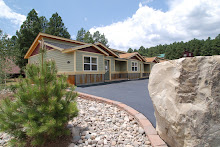
Friday, March 21, 2008
The Town and County Try Something New: working together to build the future
At stake on the agenda was the two incompatible plans of the County Community Plan and the Town Comprehensive Plan. Stuck somewhere in between were the applicants for the Blue Sky project on Highway 84, partially in the Town’s jurisdiction and partially in the County’s jurisdiction.
The County’s incomplete Community Plan calls for one house for each 35 acres. The Town’s Comprehensive Plan could allow for up to one dwelling per acre. Neither document fully supports modern land use planning for “smart growth” cluster development. The Town has only just begun discussing, understanding, and approving a few mixed-use, pedestrian-oriented projects.
The larger topic on the table was the need for a common plan --shared by both the Town and the County -- which defines where urban stops and rural begins.
The need for a single greater-Pagosa plan is the opportunity for the Town and the County to finally sit down and work together. A project to establish an agreed upon Urban Services limit map and Intergovernmental Agreement (IGA) about how the Town and County will work together on land use planning issues provides a major opportunity step forward for Pagosa to acknowledge its one-community reality.
Then on Thursday night, March 20th, the Town held a “discussion on economic development challenges in Pagosa Springs”. The room was packed with almost 100 people, a very large crowd for a Town Council meeting.
The crowd was invited to state their concerns, one at a time for three minutes or less. Re-occurring themes of: business on the brink of financial collapse, the prohibitively high cost of new development as a result of developer fees, and the stringent limitations of the Town signage ordinance were mentioned again and again.
Business owners, developers, County Commissioner Bob Moomaw, economic development coordinator Bart Mitchell, PAWS directors, interim County Manager Greg Schulte and a host of others came to the podium to share their concerns and ideas with the Town Council.
Greg Schulte recited some of the details of his background he had written about in the Durango Herald in January. Previously, Schulte was a division manager for the city of Sacramento, California Development Services Department. “At one time, the city of Sacramento was also viewed as unpredictable, complicated, unclear and unnecessarily expensive for people going through the development process.” The city of Sacramento went from “dead last” in effectiveness out of 16 jurisdictions in the region to fourth in a period of one year. Schulte cites that experience as an example of what could just as easily happen in our Town and County, if we choose it.
Whether intentionally or not, the focus of energy of the Town meeting revolved around the “new blood” leadership of Mark Weiler who was only appointed to the Town Council March 4th. Weiler is a man on a mission, with an agenda and has a natural ability to lead a crowd.
Mark Weiler stood up at the end of the two hour “discussion on economic development challenges” and delivered his proposed policy plan distilled from three full days of listening to public input.
Weiler proposes that the Town, for the remainder of the year, waive all Building and Impact fees. Secondly, place a moratorium on the sign and banner ordinance to allow the public to post whatever signs they desire, for the year. Third, move intentionally towards formation of one regional government between the County and the Town.
The fourth proposal apparently came out of an idea initiated by Mike Heraty of The Pagosa Source, earlier in the week, to the Town Tourism Committee. The plan is to nationally market a local athletic event with big prize money during a slow period of the summer from Tuesday through Thursday, thus capturing new tourist interest.
Mark Weiler spoke of “three evolutions” which have occurred in our county. At first it was an economy of natural resources - the lumber. Then the county moved into livestock. As viable businesses, these first two phases are essentially dead.
Currently, Weiler says, we are in the mature phase of our tourism evolution.
The next “evolution”, he cites, will be the attraction of the knowledge-based worker. The knowledge-based worker brings their own job with them. Weiler used Scott MacKenzie, account manager for CenturyTel, as an example of the knowledge-based worker. Mr. MacKenzie helped Parelli Natural Horsemanship set up the largest information technology link in our county connected to CenturyTel’s hardwire backbone running up the highway to Durango. But MacKenzie is able to accomplish his work without an office, Weiler says.
Mark Weiler is the president of Parelli Natural Horsemanship. In a video produced by Bill Hudson for the PagosaDailyPost, February 8, 2008, Mr. Weiler described the “connectivity” of the new Parelli Headquarters in Aspen Village, installed with the help of CenturyTel’s Scott Mackenzie.
Speaking about Parelli, Mr. Weiler says that “In our business, the department that has grown the fastest is our IT department. And all of the people that are up there are snowboarders, mountain bikers, hikers, skiers, and so forth.”
“If you think about the future of this community, the future will be based on the economic vitality of the knowledge-based workers here.”
“Knowledge-based workers will not come to an area unless they can have reliable, excellent ability to communicate.”
“What we are starting with (in our new headquarters connectivity) is ten times what I have now.”
Scott MacKenzie further noted that “The long term ramifications of this is it really puts down the foundation for sustainable, economic growth in communities like Pagosa Springs.” (Bill Hudson video on PagosaDailyPost.com)
At one point in the Town Council “discussion on economic development challenges”, developer David J. Brown stood up and mentioned the old Pagosa Springs attitude of “the glass is only half full”. A number of speakers who followed applauded David Brown's comments and his guidance towards the fact of our overflowing abundance of natural wealth here in Pagosa Springs. Our natural resources continue to attract both tourists and new residents alike.
And so, Mark Weiler’s final comments were about Town Mayor Ross Aragon. Apparently, on the desk in Mayor Aragon’s office, the first thing that you see are the words “We can do it”.
Sunday, March 16, 2008
Alan Greenspan writes in the Financial Times: worst financial crises since WWII
Home price stabilisation will restore much-needed clarity to the marketplace because losses will be realised rather than prospective. The major source of contagion will be removed. Financial institutions will then recapitalise or go out of business. Trust in the solvency of remaining counterparties will be gradually restored and issuance of loans and securities will slowly return to normal. Although inventories of vacant single-family homes - those belonging to builders and investors - have recently peaked, until liquidation of these inventories proceeds in earnest, the level at which home prices will stabilise remains problematic.
The American housing bubble peaked in early 2006, followed by an abrupt and rapid retreat over the past two years. Since summer 2006, hundreds of thousands of homeowners, many forced by foreclosure, have moved out of single-family homes into rental housing, creating an excess of approximately 600,000 vacant, largely investor-owned single-family units for sale. Homebuilders caught by the market's rapid contraction have involuntarily added an additional 200,000 newly built homes to the "empty-house-for-sale" market."
Thursday, March 13, 2008
All the water and air on earth gathered into spheres and compared to the Earth
Saturday, March 1, 2008
The Timeline for County Home Rule petition
County Home Rule Ballot Question
Timeline to be included on the 2008 General Ballot
May 7,2008 Petition Format to be submitted to County Clerk
May 9,2008 Clerk verifies Petition Format can have up to 2 days
May 9 - July 7 2008 Petition to be circulated (must obtain 435 signatures)
July 7 - July 17 2008 County Clerk shall verify signatures on the petition
(may take from 1 -10 days)
ASAP after verifying meeting of the BoCC is scheduled to call the election And to divide the county into three compact districts
July 24, 2008 Clerk's Office to prepare candidate packets
July 24, 2008 BoCC must publish a notice of election, district boundaries and call for candidates at least 60 days before election for a November election no later than July 25,2008
August 25, 2008 Candidate petitions and statements are to be filed with the clerk within thirty days after publication of election notice.
Ongoing Petitions submitted by candidates for charter commission are reviewed by clerk's office for sufficiency. (may take from 1 to 10 days)
Board to pass resolution adopting ballot language.
August 26, 2008 IGA must be signed with Clerk
September 4, 2008 Second notice of election must be published And include the names of candidates.
September 5, 2008 Ballot language must be certified to Clerk 60 days in advance of election.
October 3, 2008 Ballots must be printed and in possession of the Clerk
November 4, 2008 Election Day









